Colloquia for Fall 2009
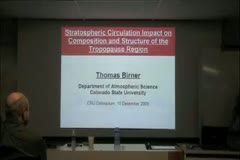
Stratospheric circulation impact on composition and structure of the tropopause region
December 10, 2009
Thomas Birner (CSU)
Hosted by
The stratospheric circulation (often referred to as Brewer-Dobson circulation) is a mechanically driven global scale circulation that transports mass and constituents (e.g. ozone and water vapor) from the cold tropical tropopause to the warmer extratropical regions. This circulation induces adiabatic cooling within its tropical upwelling branch and adiabatic warming within its extratropical…

The 8 May 2009 "Super Derecho": A Land-Hurricane?
December 03, 2009
Morris Weisman (NCAR)
Hosted by Sue van den Heever
During the morning of 8 May, 2009, a large bow echo system developed over Kansas and proceeded eastward, producing an extensive swath of severe wind damage from eastern Kansas through southern illinois. During its most intense phase, the bow echo occluded, producing an eye like structure similar in many respects to tropical cyclones. Indeed, much of the wind damage with this system was…

Understanding Avalanches: A Theoretical Framework and Practical Approach
November 19, 2009
Ethan Greene (CO Avalanche Info Center)
Hosted by Jeff Collett
Avalanches are significant natural hazards that affect people living in and traveling through most mountainous regions of the world. In Colorado, avalanches kill more people annually that any other natural hazard. Avalanches also have a significant impact on the state’s economy as they affect winter recreation, close roads, and limit the movement of goods and services. Each winter the…

Nonequilibrium Statistical Mechanics and Climate Variability
November 12, 2009
Jeff Weiss (UC Boulder)
Hosted by Thomas Birner
The variability of climate features has significant human impacts but is difficult to model and predict. Recent theoretical developments in nonequilibrium statistical mechanics cover a class of simple stochastic models that are often used for climate phenomena. The theory for entropy production is developed for simple stochastic climate models and applied to observed tropical sea surface…

Evaluation of U.S. NOx emissions with satellite-based observations and model simulations
November 05, 2009
Greg Frost (NOAA)
Hosted by Colette Heald
Nitrogen oxides (NOx = NO + NO2) of anthropogenic origin are produced primarily from fossil fuel combustion by motor vehicles, electrical power generation, and industrial processes. Accurate accounting of NOx emissions is crucial for the prediction of the atmospheric formation of ozone and particulate matter. Each of these pollutants is subject to air quality standards in most of the…

Dinosaur forecast: cloudy, and other lessons from past warm climates
October 30, 2009
Eli Tziperman (Harvard)
Hosted by David Randall
The geologic record is a fascinating source for surprising information on past warm climates. The climate of the Cretaceous and Eocene (146-34 Million years ago) was exceptionally warm. Crocodiles and Palm trees, which cannot survive a few nights of sub freezing temperatures, could be found in the waters of Greenland and in the middle of present day Northern North America, where current winter…

Multispectral aerosol optical depth retrievals from high-resolution satellite imagery
October 15, 2009
Phil Durkee (Naval Postgraduate School)
Hosted by Thomas Vonder Haar
(with contributions from Kurt Nielsen, Nick Vincent, Jack Evans, Ryan Dombrock, Brian Rivenbark, and Brian Belson) The advancement and proliferation of commercial high-resolution imaging satellites presents a new opportunity for overland aerosol characterization. Current aerosol optical depth retrieval methods typically fail over areas with high surface reflectance, such as urban areas and…
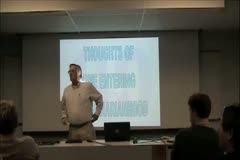
A look back at the changes in Meteorology (Atmospheric Science) since the early 1950's
October 08, 2009
Bill Gray (CSU)
Hosted by
This talk discusses the large changes in the ideas and the practice of meteorology (and atmospheric science) since I entered the field in the early 1950s. The dominant change has been the evolution of technology (computer, satellite, etc.) and the massive growth (since Sputnik in 1957) in federal funding for research. This growth has, overall, been very beneficial to society. Nevertheless, a…
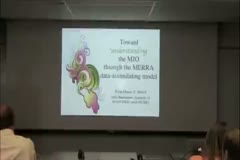
Studying the MJO and tropical waves through data assimilation
September 22, 2009
Brian Mapes (Univ of MiamI)
Hosted by Eric Maloney
The Madden-Julian oscillation is a robust, well-observed, and easily resolvable (large scale) phenomenon that global atmosphere models are notoriously poor at simulating. Analysis tendencies (ATs) in data assimilation can be interpreted essentially as model physics error fields. Systematic errors in precipitation melting and re-evaporation are easily spotted using time-averaged ATs. Of course,…

Arctic Climate Change and Sea Ice Decline
September 17, 2009
Ted Scambos (NSIDC)
Hosted by Dave Thompson
A profound change is underway in the thin but climatologically critical ice cover of the Arctic ...
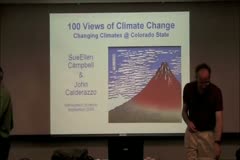
100 Views of Climate Change
September 10, 2009
John Calderazzo & SueEllen Campbell (CSU)
Hosted by Scott Denning
The great woodblock artist Hokusai looked at Japan's Mount Fuji from almost every perspective imaginable-up close and far away, as weather-catcher, spiritual inspiration, the one seemingly solid point in a roiling seascape. He called his work "100 Views of Fuji." With this as inspiration, the Changing Climates @ Colorado State education and outreach initiative looks at climate change from the…
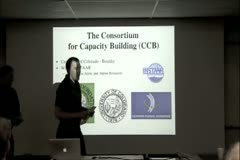
Our war with Climate
September 03, 2009
Michael Glantz
Hosted by Eric Maloney
Societies have been at war with their climate regimes, most likely since the beginning of humankind. They had to devise ways to find or make shelter appropriate to their local climates, find and store foods for long periods on time across the seasons, find and store water, protect themselves from natural climate, water and weather related hazards. That so-called war continues today. But now…
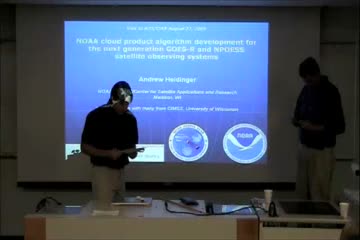
NOAA cloud product algorithm development for the next generation GOES-R and NPOESS satellite observing systems
August 27, 2009
Andrew Heidinger (SSEC/Univ of Wisconsin)
Hosted by Steve Miller
The NOAA fleet of meteorological satellite imagers is undergoing a major transition. The GOES-R Advanced Baseline Imager (ABI) and the NPOESS Visible Infrared Imager Radiometer Suite (VIIRS) will be launched soon and both offer new capabilities over the current operational imager sensors(POES/AVHRR and GOES I-M/NOP). To exploit these new sensors, NOAA/NESDIS and its partners have developed…
